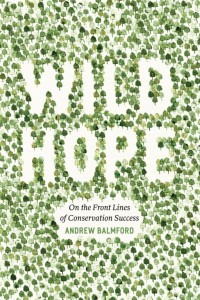I count the author of this book as a friend and therefore you might want to discount all the good things I am going to write about his excellent book – please don’t do that.
 Professor Andrew Balmford FRS is one of just a handful of UK academics who understands nature conservation through doing it, talking to people who do it and thinking hard about it. As such, his book is likely to be worth reading, and it is.
Professor Andrew Balmford FRS is one of just a handful of UK academics who understands nature conservation through doing it, talking to people who do it and thinking hard about it. As such, his book is likely to be worth reading, and it is.
The title comes from the author’s wish to concentrate on good news stories, and so he chooses conservation success stories from each continent to build a picture of ‘Yes we can!’ nature conservation. The subtitle of ‘On the front lines of conservation success’ makes this approach clear.
Each of his chosen case studies is described with clarity, with personal experiences and through conversations with the main protagonists.
I first read the American example, of red-cockaded woodpeckers, longleaf pines and the Endangered Species Act. It is fascinating, I learned a lot and it made me think about nature conservation approaches. Each chapter will do the same to you.
And I am glad that Andrew tells some of the story of the campaign to protect nature close to his home in Ely with which he has been considerably involved. He would probably quite like me to plug this event which is a fundraiser for more local action.
This book is an uplifting read. It should be on the bookshelf of all conservationists, as all conservationists sometimes need cheering up! It is thoughtful, well-written and thought-provoking.
Wild Hope by Andrew Balmford is published by the University of Chicago Press. How much you pay for it will depend on what format you buy it in and how clever you are at tracking down discounts. There doesn’t seem to be a price for a book anymore. I haven’t seen it over-priced anywhere – it’s worth it.
[registration_form]
Sounds a fascinating book, one to enjoy when I’ve finished Fighting for Birds. Just reading the chapter on “The raptor haters” and it reminded me of this recent review of a novel “Bird Brain” by Guy Kennaway:
Tom Sharpe meets Watership Down in the hugely enjoyable story of Basil “Banger” Peyton-Crumbe, a man who, having exulted in the slaughter of gamebirds all his life and neglected his wife and child, is killed in a shooting accident and reincarnated as a pheasant. Here all animals can communicate with each other but not with humans. Dogs, cats, birds, rabbits, insects: all trade insults, pass on news or plead for their lives; faithful pets feel acute frustration at being unable to get through to their slow-witted owners. In his new body, once-murderous Banger uses his old hunting knowhow to try to minimise the slaughter of his avian brethren, while the local plod’s dog makes a better fist of solving the case of Banger’s death than his master. It would not be quite accurate to say the book anthropomorphises animals because they all retain, quite brilliantly, their animal natures, but at the same time Banger, even as a dim bird, begins to gain insights into his shortcomings as a human being. Funny, astute and completely absorbing.
I often wondered why I read this blog. Now I now why! Read the reviews here – http://www.amazon.co.uk/Bird-Brain-Guy-Kennaway/product-reviews/1445881896/ref=sr_1_1_cm_cr_acr_txt?ie=UTF8&showViewpoints=1
Mark – thank you for publicising this book, which does indeed look fascinating.
If there were to be a poll to follow the New Elizabethan Naturalists of the best loved or most influential book on conservation, wildlife or natural history I wonder who the winners would be?
MK – that had occurred to me, too. Maybe I’ll do just that. Who would you nominate?
Oooh crikey – Oliver Rackham ‘The History of the Countryside’, Richard Mabey ‘The Common Ground’, anything by Derek Ratcliffe, Gerald Wilkinson ‘Epitaph for the Elm’ … but that may as much a reflection on what’s influenced me rather than what’s been influential. Honorable mention for Fighting for Birds of course (although you’d probably have to wait a few years to fairly judge it’s impact?)
(although you’d probably have to wait a few years to fairly judge it’s impact?)
MK – interesting choices (leaving aside Fighting for Birds). I don’t know epitaph for the Elm. Thank you.
Mark – do get hold of Epitaph for the Elm if you can, it’s a beautiful book (although some thirty years on a slightly better title might have been ‘epitaph for the mature elm’). And I’ve a new entry on my “bucket list” (and a suggestion for yours perhaps?), which comes from another book ‘Heritage Trees: Britain and Northern Ireland’ by Jon Stokes, Donald Rodger and Archie Miles. This is to go and see the ‘Preston Park Pair’, reputedly the two largest surviving English Elms at Preston Park in Sussex. I do hope that Brighton and Hove’s elm control programme will survive the public sector cuts…